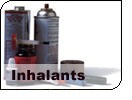|
|
|
|
 |
| Inhalants |
 What is inhalant abuse? What is inhalant abuse?
Inhalant abuse is the deliberate inhalant or sniffing of common products found in homes and schools to obtain a "high."
Inhalant abuse can kill!
It can kill suddenly, and it can kill those who sniff for the first time. Every year, young people in this country die of inhalant abuse. Hundreds suffer severe consequences, including permanent brain damage, loss of muscle control, and destruction of the heart, blood, kidney, liver, and bone marrow. Today more than 1,000 different products are commonly abused. The National Institute on Drug Abuse reported in 1996 that one in five American teenagers have used inhalants to get high. |  | | Many youngsters say they begin sniffing when they're in grade school. They start because they feel these substances can't hurt them, because of peer pressure, or because of low self-esteem. Once hooked, these victims find it a tough habit to break. |  | What are the effects of inhalant abuse?
Sniffing can cause sickness and death. For example, victims may become nauseated, forgetful, and unable to see things clearly. Victims may lose control of their body, including the use of arms and legs. These effects can last 15 to 45 minutes after sniffing. |  | | In addition, sniffing can severely damage many parts of the body, including the brain, heart, liver, and kidneys. |  | | Even worse, victims can die suddenly -- without any warning. "Sudden Sniffing Death" can occur during or right after sniffing. The heart begins to overwork, beating rapidly but unevenly, which can lead to cardiac arrest. Even first-time abusers have been known to die from sniffing inhalants. |  | What products are abused?
Ordinary household products, which can be safely used for legitimate purposes, can be problematic in the hands of an inhalant abuser. The following categories of products are reportedly abused: glues/adhesives, nail polish remover, marking pens, paint thinner, spray paint, butane lighter fluid, gasoline, propane gas, typewriter correction fluid, household cleaners, cooking sprays, deodorants, fabric protectors, whipping cream aerosols, and air conditioning coolants. |  | How can you tell if a young person is an inhalant abuser?
If someone is an inhalant abuser, some or all these symptoms may be evident:- Unusual breath odor or chemical odor on clothing.
- Slurred or disoriented speech.
- Drunk, dazed, or dizzy appearance.
- Signs of paint or other products where they wouldn't normally be, such as on the face or fingers.
- Red or runny eyes or nose.
- Spots and/or sores around the mouth.
- Nausea and/or loss of appetite.
- Chronic inhalant abusers may exhibit such symptoms as anxiety, excitability, irritability, or restlessness.
|  | What could be other telltale behaviors of inhalant abuse?
Inhalant abusers also may exhibit the following signs:- Sitting with a pen or marker near nose.
- Constantly smelling clothing sleeves.
- Showing paint or stain marks on the face, fingers, or clothing.
- Hiding rags, clothes, or empty containers of the potentially abused products in closets and other places.
|  | What is a typical profile of an inhalant abuser in the U.S.?
There is no typical profile of an inhalant abuser. Victims are represented by both sexes and all socioeconomic groups throughout the U.S. It's not unusual to see elementary and middle-school age youths involved with inhalant abuse. |  | What can you do to prevent inhalant abuse?
One of the most important steps you can take is to talk with your children or other youngsters about not experimenting even a first time with inhalants. In addition, talk with your children's teachers, guidance counselors, and coaches. By discussing this problem openly and stressing the devastating consequences of inhalant abuse, you can help prevent a tragedy. |
 |
|
|



